A tasty and healthy medicine from your own garden: pumpkin treatment for a number of diseases
Pumpkin is a delicious, inexpensive and very healthy product. This vegetable has long been used not only in cooking, but also in the treatment of many pathologies. Traditional medicine considers the pulp of pumpkin fruits as a universal remedy for the treatment and prevention of a wide range of diseases.
Is this really so, and is it true that the vegetable has unique healing powers? Find out from this article about pumpkin treatment, what are the contraindications, in what form to use in order to get the most benefit, and what can be prepared from it.
The content of the article
The benefits and harms of pumpkin
What are the benefits of pumpkin for human health? A vegetable is classified as an irreplaceable product: it is necessary for normal growth and development of a person, slowing down the aging process, maintaining the functions of the organs of the cardiovascular, genitourinary, digestive, and nervous systems... The versatile effect is due to the fact that the chemical composition is rich in vitamins, minerals, fiber, protein, iron, calcium, zinc and many other vital elements.
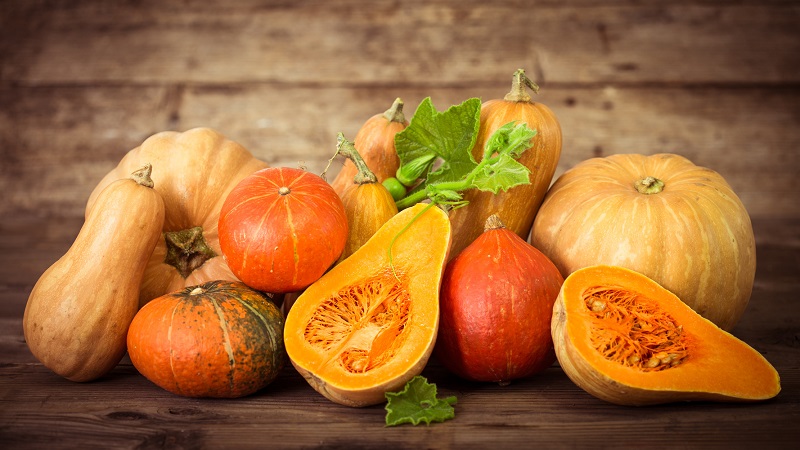
Among the main functions of a vegetable, the following are distinguished:
- strengthens and improves the elasticity of the walls of blood vessels of the brain and heart;
- is an effective means of preventing atherosclerosis, ischemia, heart failure;
- stabilizes high blood pressure;
- normalizes metabolism;
- supports the processes of hemodynamics at the physiological level;
- slows down the aging process in the body;
- plays an important role in the formation of new cells;
- activates metabolism;
- removes salts of heavy metals, slags, toxins from the body;
- has a diuretic and laxative effect;
- takes part in the formation of antimicrobial immunity;
- improves the functioning of the gastrointestinal tract;
- protects the liver from the aggressive influence of external and internal factors;
- calms the nervous system;
- normalizes weight;
- strengthens bone tissue.
Separately, it should be noted the usefulness of pumpkin for men... Its components take part in the production of steroid hormones, the presence of which is necessary to maintain sexual health, sexual functions, the formation of muscle tissue, the prevention of prostatitis, infertility. Zinc and phosphorus improve sperm composition, increase sexual activity, and provide sperm motility, in which fertilization is possible.
Reference! Experts recommend using pumpkin during pregnancy, as it saturates the body of the mother and the unborn child with vitamins, micro- and macroelements necessary for the normal growth and development of the fetus.
Even the healthiest product has pros and cons, and pumpkin is no exception.... All the same components of the composition, when used haphazardly, can harm the body. So, an excess of retinol (vitamin A) can provoke vomiting, nausea, yellowness of the skin, exacerbation of gallstone disease, headaches, soreness in the lower extremities.
Pumpkin threatens the health of patients with diabetes mellitus degree 1... Due to the presence of fructose, sucrose and lactose in the composition, it can cause an increase in blood glucose levels, which threatens the development of complications: renal failure, stroke, myocardial infarction, gangrene of the extremities, in the worst case, death occurs.
Pumpkin should not be eaten raw when gastritis with high acidity, stomach ulcer and duodenal ulcer, so as not to cause exacerbation of pathology, increased symptoms.
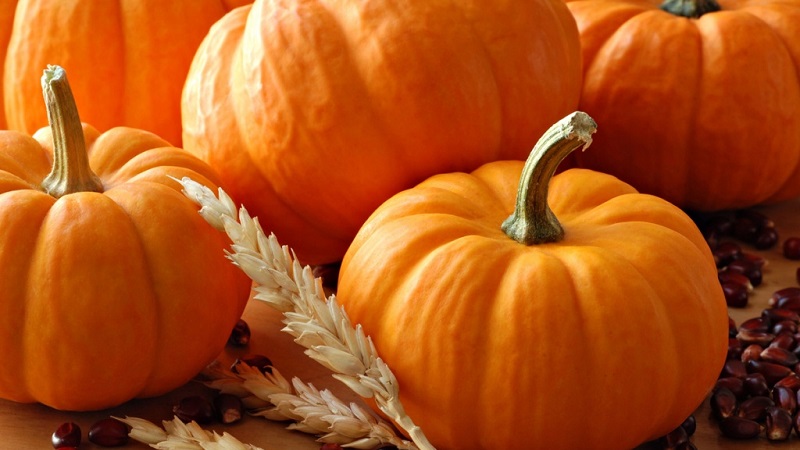
Composition, vitamins and minerals
The composition of pumpkin fruits contains a large number of biologically active components... Pumpkin is a source of protein, carbohydrates, practically does not contain fats (0.3 g per 100 g of product).
The chemical composition of pumpkin is rich in such components as:
- water - 92%;
- vitamins of group B, C, A, E, PP, K, D;
- cellulose;
- pectin;
- amino acids;
- a nicotinic acid;
- omega-3 fats;
- glucose.
Of the minerals in pumpkin fruits, there is calcium, potassium, copper, iodine, iron, zinc, phosphorus, vanadium, cobalt, silicon, rubidium, sulfur, sodium, fluorine.
Read also:
The benefits and harms of pumpkin for the body
Pumpkin and honey for the liver: how to cook and eat correctly
How to take pumpkin seed oil for prostatitis and how it will help
Healing properties
What does pumpkin heal? Traditional medicine has long used a vegetable for hypertension, atherosclerosis, anemia, prostatitis, impotence, liver cirrhosis... Due to its rich chemical composition, pumpkin affects the condition and functions of various organs and systems. According to nutritionists, provided that the vegetable is regularly consumed in a few days, you can cleanse the body of toxins and toxins, improve overall well-being, and increase endurance and performance.
Due to the large amount of protein and carbohydrates in the composition and the low percentage of fat, pumpkin is included in baby and diet food... Plant fiber removes excess fluid, cleanses the digestive tract, provides a feeling of fullness, which allows you to reduce the volume of servings, normalize weight. The ability of pumpkin to suppress the inflammatory process, neutralize stagnation, destroy pathogenic microorganisms is used to treat prostatitis, infections of the genitourinary system.
Pumpkin pulp is indicated for people with diseases of the digestive system, in particular with damage to liver tissue. The vegetable has a hepatoprotective effect: it restores the activity of the liver, has a detoxifying effect, ensures the replenishment of the deficiency and the synthesis of the required amount of protein, protects biological membranes from the action of undesirable factors of the external and internal environment.
Calcium in pumpkin is an important element of electrolyte balance... It is necessary for the contraction of muscle fibers, the transmission of nerve impulses, and the normal functioning of the blood coagulation system. In addition, it promotes the formation of bone and dental tissue, increases the mineral density of bones, inhibits their destruction.

What and how pumpkin heals
Pumpkin has a choleretic, anti-inflammatory, tonic effect, improves the functioning of the gastrointestinal tract, relieves anxiety, relieves constipation.
The pulp of the fruit is used to treat and prevent diseases such as:
- gout;
- cholelithiasis;
- diabetes;
- cholecystitis;
- hepatitis;
- heart failure;
- ischemia;
- mastopathy;
- atopic dermatitis;
- hemorrhoids;
- prostatitis;
- obesity;
- nervous disorders;
- atherosclerosis;
- hypertension;
- impotence;
- endometrial pathology.
In winter, pumpkin is taken to replenish the deficiency of vitamins, micro- and macroelements, increase the protective functions of the immune systemprevent the penetration of infection into the upper respiratory tract.
Pumpkin treatment
Consider below, what is the usefulness of a vegetable for a certain disease, in what form and how to use it correctlyso as not to harm the body.
With gout
Pumpkin for gout increases the effectiveness of antibiotics, has a diuretic effect, prevents the reabsorption of uric acid and accelerates its excretion, reduces the synthesis of urate microcrystals, thereby preventing the deposition of salts. The benefit of the fetus in the treatment of gouty arthritis lies in the ability to curb inflammatory reactions, ease the severity of symptoms, and improve the composition and condition of bone and cartilage tissue.
Traditional medicine suggests using pumpkin raw or after heat treatment to treat gout. It is boiled, stewed, baked, steamed, processed into juice, mashed potatoes. For medicinal purposes, pumpkin seeds and oil are also used.
With gallstone disease
Pumpkin with gallstone disease has a choleretic and hepatoprotective effect:
- stimulates cellular immunity;
- lowers cholesterol levels;
- reduces the level of dangerous acids;
- dissolves cholesterol stones;
- stimulates the production of bile and its secretion;
- protects the digestive organs from the effects of bile salts.
The vegetable is useful in any form... Also, the fruits are used for making desserts, jam, pudding.
With cholecystitis
With cholecystitis, pumpkin is recommended as a choleretic agent to stimulate bile formation and improve the outflow of bilereducing the concentration of bile acids, which are toxic to organ cells. Regular consumption of a vegetable has a beneficial effect on the state of the cell membranes of the digestive tract: they become immune to the influence of aggressive external and internal factors.
Important. For the treatment of cholecystitis, pumpkin seeds, oil, or pumpkin juice are preferred.
From mastopathy
Mastopathy is a disease of the mammary glands, characterized by the appearance of dense painful formations... Pumpkin helps to get rid of fibrocystic growths, relieve the severity of symptoms, has an immunomodulatory and tonic effect on the body. In addition, it acts as an anti-inflammatory and pain reliever.
With mastopathy, the pulp of the fruit is consumed raw or baked, stewed, boiled, compresses are prepared for outdoor use. For medicinal purposes, pumpkin juice, seeds, oil are taken.
With diabetes mellitus
Opinions about the benefits of pumpkin for diabetes are controversial... Due to the presence of sugar in the composition, it is recommended to consume fruits in limited quantities. A vegetable is necessary for a nutritious diet for diabetics, as it saturates the body with proteins, carbohydrates, minerals, vitamins and practically does not contain fats, which makes it possible to control weight.
Besides, the product normalizes metabolism, is a good antioxidant, neutralizes free radicals, plays an important role in the formation of new cells, lowers blood cholesterol levels. The composition contains chiro-inositol, which is responsible for the production of insulin in the body.
In diabetes mellitus, pumpkin pulp, seeds, oil are consumed as an independent food product or combined with others... Pumpkin flowers accelerate the healing process of wounds, trophic ulcers, which often bother patients. Dried inflorescences are ground into powder, applied to the site of damage.
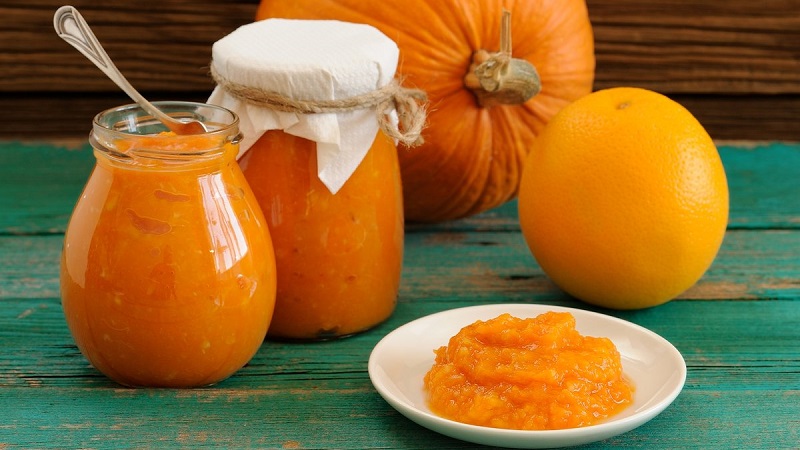
For atopic dermatitis
Pumpkin is included in the list of foods with a low degree of allergenic activity, therefore it is allowed on the menu for atopic dermatitis... The use of the product satisfies the body's needs for zinc, calcium, potassium, iron, phosphorus, vitamins A, B, C, E and other useful micro- and macroelements. The presence of nicotinic acid in the composition has a positive effect on the condition of the skin.
It will be interesting:
What is pumpkin honey: medicinal properties and contraindications
How to take pumpkin seed oil: benefits and harms for the body
From cholesterol
Pumpkin fruits are rich in vegetable fiber, which cleans well the digestive tract, kidneys, blood, renal system, removes excess fluid from the body.
Among the main functions of the cholesterol product are the following:
- normalizes metabolic processes;
- regulates protein synthesis;
- improves intestinal peristalsis;
- activates the outflow of bile;
- evens out blood pressure;
- prevent the accumulation of lipids, which is important for the prevention of arterial damage by cholesterol deposits.
From prostatitis
Pumpkin for prostatitis acts as an anti-inflammatory agent, activates metabolism and hemodynamic processes, destroys pathogenic microorganisms, which has a beneficial effect on the course of the disease.
With the help of regular consumption of a vegetable, you can shorten the course of treatment, reduce the need for pharmacological preparations, alleviate the severity of symptoms, prevent the chronicity of the disease and the development of complications.
Pumpkin pulp is used to treat inflammation of the seminal gland., more often - in combination with honey: pumpkin seeds are prepared with honey water. A medicine for microclysters, suppositories and tampons for rectal administration are obtained from pumpkin seed oil.
With hemorrhoids
For hemorrhoids, alternative medicine advises to include the pulp of pumpkin fruits in the daily diet... The vegetable has an anti-inflammatory and laxative effect, saturates the body with useful micro and macro elements, vitamins, stimulates intestinal motility, reduces the accumulation of toxic products of protein decomposition, improves the microflora in the large intestine.
Pumpkin juice acts as a laxative: normalizes the consistency of feces, facilitates the process of defecation, enhances the peristalsis of the large intestine and inhibits the reabsorption of water. To relieve swelling, inflammation and reduce pain to hemorrhoids, it is advised to apply gruel from crushed pumpkin fruits.
For endometrial growth
For the growth of the endometrium, the pulp of pumpkin fruits, pumpkin juice and seeds help... Due to the varied chemical composition, the vegetable ensures the formation of the normal structure of the inner mucous layer of the uterus. Vitamin E has a beneficial effect on the organs of the female genital area.
It is a powerful antioxidant, protects cell structures from destruction, stimulates the production of steroid hormones, stabilizes hormones, improves the quality of the egg, increases the likelihood of fertilization and minimizes the risk of involuntary termination of pregnancy.
Reference! If the cause of the violation of the structure of the endometrium is an inflammatory lesion of the pelvic organs, it is recommended to use tampons with pumpkin oil in the vagina.
For kidneys
Pumpkin kidney treatment helps cleanse the gallbladder and repair liver tissue... In addition, the vegetable has a diuretic effect, promotes the rapid elimination of toxins from the body, prevents the progression of inflammation, and prevents the formation of salt stones in the organ. To get the most positive effect on the organs of the urinary system, it is recommended to cook dishes where pumpkin pulp is combined with honey.
Pumpkin juice in combination with other vegetable or fruit juice will bring benefits... Traditional medicine advises taking 1 tsp for therapeutic and preventive purposes. pumpkin seed oil on an empty stomach for 30 days.
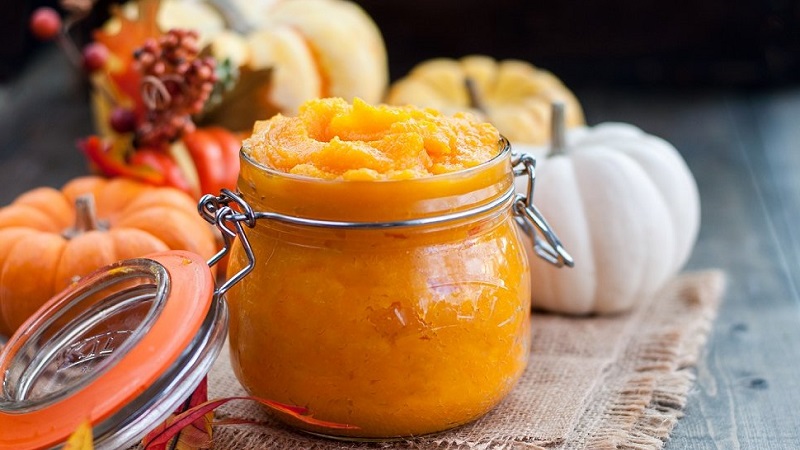
For heart
The composition of pumpkin fruits contains many useful micro and macro elements, as well as zinc, potassium, iron, magnesium, which are important for maintaining the normal functioning of the myocardium..
Dishes made from pumpkin pulp and its seeds have a positive effect on the state of the heart and blood vessels: they increase the elasticity of the vascular walls, normalize blood circulation, and eliminate congestion. Nutritionists advise to introduce pumpkin into the menu for the prevention of atherosclerosis, hypertension, ischemia, heart failure.
In what form to use
In what form is it better to use pumpkin - raw, after heat treatment or replace with oil, seeds, juice, must be considered in the case of a particular patient, taking into account age, developmental characteristics and course of the disease, the presence of concomitant pathologies.
Pumpkin fruits are consumed fresh, added to vegetable and fruit salads. However, if there are problems with the gastrointestinal tract, gastritis with high acidity, gastric ulcer and duodenal ulcer, it is better to refuse fresh vegetables so as not to aggravate the health condition.
Pumpkin after heat treatment is no less useful for the body... Subject to the preparation technology, the chemical composition of the vegetable remains practically unchanged. In this case, the product is more easily absorbed by the body, digested faster, does not cause a threat of exacerbation of the disease from the organs of the digestive system.
Enough a large amount of useful elements and vitamins are found in pumpkin juice, oil and seeds... Pumpkin seed oil is rich in zinc, flavonoids, sterols, phytoestrogens. It is necessary for people suffering from hypertension, its use has a beneficial effect on the condition of the teeth, the strength of the bones. Pumpkin seeds are used as an effective antihelminthic agent, including when infected with tapeworms.
reference... Ripe fruits are used for making jam, fruit preserves, added to baked goods, desserts, jelly, processed into caviar, unripe pulp is salted and pickled.
Recipes
A wide variety of dishes are prepared from pumpkin or consumed as an independent food product.... Today, a huge number of recipes are known. Let's consider a few of the simplest and most delicious ones.
Pumpkin puree soup
Ingredients:
- 250 ml of water;
- 0.5 kg of peeled pumpkin pulp;
- 2 carrots;
- 2 onions;
- 2 tbsp olive oil;
- greens to taste.
Recipe:
Cut vegetables into medium-sized cubes, pour over low-fat broth or purified water, add 2 tbsp. l. oils, salt to taste... Cook over low heat, covered, until vegetables are tender.
The average cooking time is 30 minutes, but may take longer depending on the type of pumpkin. Grind the cooled vegetables with a blender. Add greens in portions, optionally - 1 tbsp. low-fat cream. Serve with croutons and bread.
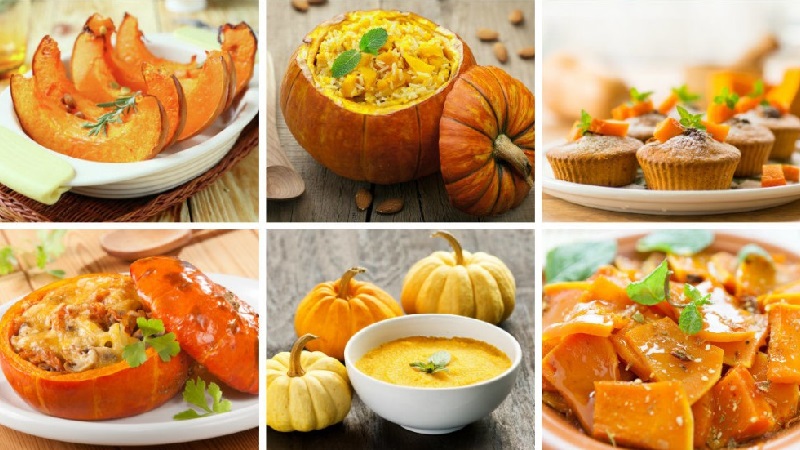
Pumpkin salad
Pumpkin salad can be consumed without restriction throughout the day... In addition to the fact that the dish provides a feeling of fullness for a long time, it saturates the body with useful microelements. To prepare the salad, cut the peeled pulp into small strips or tinder it with a Korean carrot grater.
One or more fresh vegetables and / or fruits are added to taste: apple, carrot, beet, avocado, arugula, pomegranate. Season with lemon juice, vegetable oil, yogurt, cream, honey. The dish can be diversified by adding pumpkin seeds, nuts, sesame seeds.
Baked pumpkin with honey
Ingredients:
- 400 g pumpkin:
- 2 tbsp honey;
- 1 tbsp. butter or vegetable oil.
Recipe:
Cut the pumpkin peeled from the peel into pieces of the same size, mix with butter, honey... Line a baking sheet with parchment paper, lay out the product. Bake in a preheated oven for 30-40 minutes at 180-200 degrees. The finished dish can be sprinkled with sesame seeds, chopped nuts.
Contraindications
The reason for not eating pumpkin because of the harm it can do to health, there may be the following diseases and pathological conditions:
- stomach ulcer;
- gastritis with high acidity;
- diabetes;
- duodenal ulcer;
- hypersensitivity.
Reviews
Lyudmila: “My problem is being overweight. The doctor recommended including pumpkin in the diet. During the month, I regularly consumed the vegetable as part of various dishes. I was pleasantly surprised. Working capacity has increased, night sleep has improved, and most importantly, weight has decreased.Losing weight is not rapid, minus 2 kg, but without harm to the body. Pumpkin provides fast and long satiety, which allows you to reduce the size of the portions, there is no desire to snack ".
Svetlana: “Pumpkin with honey is the best way to cleanse the liver and improve overall health. I experienced it myself. Products remove excess fluid, toxins, toxins, which has a beneficial effect on health, no longer worries about the feeling of heaviness in the stomach, heartburn, the correct process of losing weight occurs. In addition, it is not only healthy and tasty, but also inexpensive ".
Conclusion
Nowadays, pumpkin remains in demand both in cooking and in folk medicine. Its regular use allows you to saturate the body with useful micro- and macroelements, normalize metabolism, improve blood supply to the body, activate the gastrointestinal tract, protect the body from atherosclerosis, ischemia, impotence, hypertension.
Taking into account the properties of the product, nutritionists advise including pumpkin in children's and diet menus. Of course, a positive result from pumpkin treatment is possible if combined with conservative therapy.